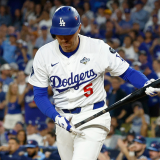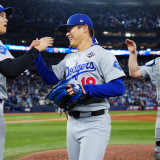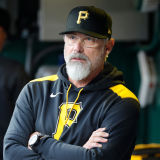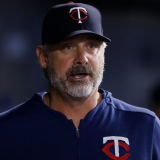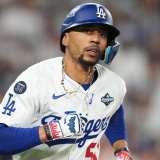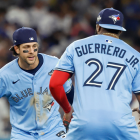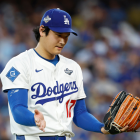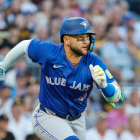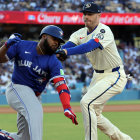
How Paul Skenes got even better: MLB's most dominant ace will win first Cy Young as Pirates fail around him
Paul Skenes, who owns a 2.00 ERA in his first two MLB seasons, leveled up in 2025
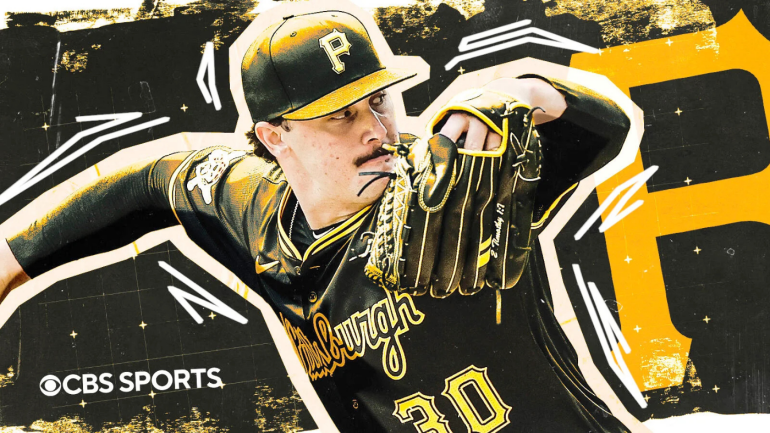
Pittsburgh Pirates ace Paul Skenes will make the 32nd and final start of his first full major-league season Wednesday night against the Cincinnati Reds. He is the heavy favorite to win the NL Cy Young Award. If it happens, he will join New York Mets legend Doc Gooden as the only pitchers in history to win Rookie of the Year one year and Cy Young the next. Gooden did it in 1984 and 1985.
"Maybe a little bit," Skenes said last month when asked if he thinks about the Cy Young (via the Pittsburgh Post-Gazette). "But it's the same thing as last year. One, the award itself is out of my hands. If it's up to the voters, it's out of your hands. Two, if you do what you're supposed to do and take care of it, keep doing the work and pitch well, it's going to take care of itself, however it should. Whether you win it or not. It's the same thing as Rookie of the Year last year. That's how I look at it."
Skenes, 23, has struck out 209 batters in 181 ⅔ innings this season and leads all qualified pitchers in ERA (2.03), ERA+ (211), FIP (2.43), and Baseball Reference WAR (7.3). He is second to Detroit Tigers ace Tarik Skubal in FanGraphs WAR. The No. 1 pick in the 2023 draft has become an instant ace. I don't think even the Pirates expected him to be this good this soon.
Of course, the Pirates are 67-89 this season, so they are guaranteed to have a worse record this year than they did in 2023 (76-86), their last season without Skenes. It's a stunning failure by the front office and ownership, especially in the expanded playoff era, when a .500-ish record can keep you in the race deep into September. The Pirates couldn't even manage that.
With that in mind, here's a look at just how good Skenes has been in his career to date, how he's getting better, and what steps the Pirates must take to build a contender around the best pitcher in the world.
Historical greatness two years in
Since being called up last May 11, Skenes has a 2.00 ERA through 54 starts and 314 ⅔ innings. He's struck out 379 batters in those 314 ⅔ innings. Skenes' 2.00 ERA is just behind Gooden for the lowest among pitchers who made at least 50 starts in their first two seasons since baseball's Live Ball Era began in 1920.
- Doc Gooden, 1984-85: 2.0013
- Paul Skenes, 2024-25: 2.0021
- Tom Seaver, 1967-68: 2.47
- Gary Nolan, 1967-68: 2.51
- Alek Manoah, 2021-22: 2.60
Adjusted ERA, or ERA+, paints Skenes in a more favorable light. ERA+ is adjusted for ballpark, the league's offensive environment, plus other factors. It allows us to better compare pitchers across eras than straight ERA. A 100 ERA+ is league average. The higher the number, the better, and the lower the number, the worse.
Here are the best ERA+ marks among those pitchers with at least 50 starts in their first two seasons since the Live Ball Era began 105 years ago:
- Paul Skenes, 2024-25: 212
- Doc Gooden, 1984-85: 176
- Alek Manoah, 2021-22: 157
- Herb Score, 1955-56: 156
- Roy Oswalt, 2001-02: 156
That 212 ERA+ tells us Skenes has been 112% better than the league average pitcher in his first two MLB seasons. That is simply remarkable. The gap between No. 1 and No. 2 on that list is the same as the gap between No. 2 and No. 12 (Tim Lincecum's 140 ERA+ from 2007-08). This level of dominance in Years 1 and 2 is unprecedented, historically.
How he's improved
As crazy as it sounds now, there were concerns about Skenes' four-seam fastball coming out of LSU. Not so much for its velocity, but because of its movement, or lack thereof. Skenes solved this by adding a sinker, or a "splinker," if you prefer to call it that. That devilish upper-90s pitch keeps hitters off the four-seamer and elevates his arsenal across the board.
Paul Skenes, 98mph Fastball and 95mph Splinker, Overlay.
— Rob Friedman (@PitchingNinja) July 7, 2025
One of many examples of why Skenes is Impossible. pic.twitter.com/IF01tdSXgd
Like most starters, Skenes deploys his arsenal differently based on the batter's handedness. He throws four-seamers, sinkers, and sweepers almost an equal amount against righties, with a handful of changeups and curveballs mixed in. Against lefties, it's twice as many four-seamers as sinkers, an equal number of changeups and sweepers, and a few curveballs.
That is a new mix against lefties. Last season, Skenes threw twice as many four-seamers as sinkers to lefties, though the curve was his most used non-fastball. He's cut the curveball usage in half against lefties and started throwing more sliders and changeups. That changeup in particular is devastating. It's held hitters to a .095 batting average and .119 slugging percentage this year.
Statcast's pitch arsenal stats, which put a run value on every pitch based on outcome, show how much Skenes has improved some of his weapons from 2024 to 2025. The four-seamer that was a question at LSU has become a force in MLB:
| 2024 | 2025 | |
|---|---|---|
Four-seamer | +7 | +20 |
Sweeper | +5 | +10 |
Changeup | +3 | +9 |
A mark of +20 runs for an individual pitch is incredible, and the +10 figure is very good. Skenes' four-seamer, sweeper, and changeup are all top six in run value among those pitch types (min. 300 thrown). Garrett Crochet is the only other pitcher with three top-six pitches (sinker, cutter, sweeper). Jacob deGrom (four-seamer, slider), Nathan Eovaldi (cutter, splitter), Kevin Gausman (four-seamer, splitter), and Cristopher Sánchez (sinker, changeup) are the only others with even two top-six pitches.
It almost seems impossible, but Skenes has leveled up this season, most notably improving the quality of his changeup. That has allowed his four-seamer to play up, and it widens his arsenal in general. This guy would be a handful if he were merely throwing upper-90s four-seamers with a changeup. Add the sinker, sweeper, and curve, and, well, you get the best pitcher in baseball.
Can the Pirates keep him long-term?
Keeping Skenes in Pittsburgh long-term, meaning beyond his six years of team control, will require a contract that frankly we have no reason to expect Pirates owner Bob Nutting to give out. Nutting is one of the sport's most miserly owners, if not the most. Here are the largest contracts in franchise history:
| Signed | Years | Dollars | |
|---|---|---|---|
April 2023 | 8 | $106.75 million | |
April 2022 | 8 | $70 million | |
Jason Kendall | November 2000 | 6 | $60 million |
March 2012 | 5 | $51.5 million | |
Brian Giles | May 2000 | 6 | $45 million |
What a pitiful list. That Kendall's modest $60 million deal (modest even by 2000 standards) stood as the richest contract in team history for more than two decades really is shameful. Nutting has not invested in his team at a level commensurate with an owner who wants to win, and a salary cap isn't the way to get him to spend more. He just has to actually care and try to win. But I digress.
Given the the team's ultra-thrifty ways, I don't blame Pirates fans who are bracing themselves for Skenes to be traded away like Giles, Kendall, McCutchen, Jason Bay, Gerrit Cole, and so many other Pirates' stars over the year. It doesn't have to be like that though. The Pirates can keep Skenes. They'll just have to award him one of the biggest contracts ever.
We have a good benchmark for a Skenes extension: Yoshinobu Yamamoto's pitcher-record 12-year, $325 million contract with the Los Angeles Dodgers. Yamamoto signed that deal going into his age-25 season, though he had years of professional experience in Japan before coming stateside. Skenes will be going into his age-24 season next year. Yamamoto was a free agent and Skenes was not, and that's a big difference, but it gets us in the ballpark.
Just thinking out loud, a long-term Skenes extension could look like this:
- 2026: $1 million (pre-arbitration year)
- 2027: $8 million (first arbitration year)
- 2028: $15 million (second arbitration year)
- 2029: $20 million (third arbitration year)
- 2030 and beyond: $35 million (free-agent years)
Skenes will take a Rookie of the Year and likely a Cy Young into arbitration, setting him up for record paydays. Corbin Burnes took just a Cy Young (i.e. no Rookie of the Year) into arbitration and was paid $6.5 million, $10.01 million, and $15.64 million those three years. Our estimated 2027-29 salaries for Skenes may seem low, but they are very high for a pitcher's arbitration years.
Anyway, Yamamoto signed his 12-year contract at age 25. Add one year to account for Skenes being one year younger now than Yamamoto was when he signed his deal, and it's a 13-year contract. A 13-year contract using those terms above works out to $324 million. Throw in a signing bonus, opt outs, and all those bells and whistles, and the Pirates could easily push it over Yamamoto's $325 million to set a new record guarantee for a pitcher.
And that's probably what it would take to keep Skenes in Pittsburgh long-term. The Pirates would have to approach him with the largest contract for a pitcher right now, and not try to get a discount. You've got to put something in front of him that blows him away, not try to nickel and dime him. You have to grab his attention. Something like, say, $350 million could do it.
There is no reason to expect Nutting to offer Skenes a record contract, of course, and such a deal would create questions about the front office's ability to build a contending team around him, but that's a front office problem, not a Skenes problem. He's making close to the league minimum this year and they still can't build a contender around him. That's not on him.
Skenes has already made a pretty good chunk of change in his career. Between his draft signing bonus and the new pre-arbitration bonus pool, his career earnings will be up around $15 million after this season. He's got some security. The longer the Pirates wait to approach him about an extension, the less likely he will be to take it. To keep him long-term, they have to try now.
"No," Skenes said recently when asked if there have been any extension talks. "That's not something I want to discuss during the season, and I think they haven't brought up anything to me out of respect for that, too. Yeah, no discussions on that."
What do they have to do to build a contender around him?
Following his final home start of the season last week, Skenes did not hold back, saying 2025 would be a "wasted year" if the Pirates did not learn from this and get better next year. He was talking primarily about the players already on the team, but he might as well have been talking about the front office and ownership as well. From the Associated Press:
"This is a wasted year if we don't learn what we need to do and we don't know why we didn't go out there and do what we wanted to do," Skenes said Friday. "If those things happen, then it's a wasted year, in my opinion. I don't think that's happening. I think — individually, as a team and as an organization — we know the adjustments we need to make. Now we've just got to do them."
...
"There's room to get better in this locker room," he said. "We just need to do it. I'm sure we'll get some pieces and do all that, but my mind right now is 'What can we do within the locker room to get better, now and for next year?' There's urgency to it, and we need to understand that and act on it."
What makes this season especially frustrating is the Pirates are an excellent run prevention team. They have allowed only 4.04 runs per game this season, seventh fewest in baseball. That's not all Skenes either. He's thrown only 13% of their innings. Skenes, Mitch Keller, Bubba Chandler, and a healthy Jared Jones is a pitching foundation you can contend with, for sure.
The Pirates have wasted that excellent run prevention because they flat out cannot hit. As a team, they rank 30th in runs scored per game (3.60), 30th in home runs (112), 28th in batting average (.231), 26th in on-base percentage (.305), and 30th in slugging percentage (.350). Spencer Horwitz, their big offseason addition, is hitting .257/.338/.402 as a first baseman. That's good, but not someone who will anchor a contender's lineup. That's a fine No. 6-7 type hitter.
Top-10 draft picks Nick Gonzales (No. 7 overall in 2020) and Henry Davis (No. 1 overall in 2021) are just guys, not capital-G Guys, and I'm not sure Davis is even that. Oneil Cruz hasn't just stalled out, he's gone backward. That has been disastrous for the Pirates. Hayes never developed as a hitter before being traded away. The Pirates are good with pitchers. They stink with hitters.
I suppose the good news is when you hit this poorly as a team, there are plenty of ways to improve. The Pirates have an $87 million payroll this year, per FanGraphs, and they have only $31 million on the books next year, not including a handful of arbitration-eligible players. They could raise payroll to, say, $110 million next year and still have a bottom-10 payroll, but it would be a big increase.
Shortstop, third base, and left field should be top priorities this winter. By WAR, the Pirates have gotten among the worst production in the league at those three positions. Going from their 2025 situations to even league-average players at those positions in 2026 would represent significant upgrades and add multiple wins to the ledger. Easier said than done, I know, but it can be done.
Bottom line, the Pirates do not have anywhere close to the offensive core needed to support an impressive pitching staff. Their hitter development has been so far below what they need to contend with a small payroll. They whiffed on two recent top-10 picks (Davis and Gonzales) and Cruz is this. The path back to contention while Skenes is still a Pirate involves fixing the offense, and they have to spend money and get better at player development to do that.


